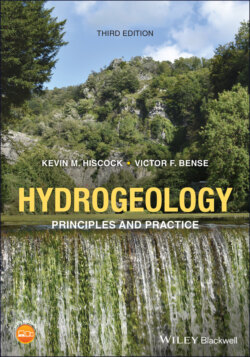Читать книгу Hydrogeology - Kevin M. Hiscock - Страница 36
1.7.1 Groundwater abstraction in the United Kingdom
ОглавлениеThe distribution of groundwater abstraction volumes in the United Kingdom is largely determined by the relationship between population and geology, with major producing aquifers in the densely populated south and east of the country and minor producing aquifers in the less‐densely populated north and west. Table 1.5 provides a breakdown of water use by purpose and type (surface water and groundwater) for regions of England. Surface water abstraction for electricity generation is the largest category, but most of the freshwater abstracted for cooling purposes is returned to rivers and can be used again downstream. For England, groundwater accounts for 20% of total abstractions (surface water and groundwater) for all water use purposes and 31% of total abstractions for domestic use. In terms of abstractions for domestic water supply, groundwater is especially significant in the Southern (75% dependence on groundwater), Anglian (36%), Thames (34%) and Midlands (32%) regions. In these densely populated regions of south‐east England and the English Midlands, good quality groundwater is obtained from the high‐yielding Cretaceous Chalk and Triassic sandstone aquifers. Groundwater is also important for spray irrigation. The Anglian region in the east of England, an area of intensive arable farming and horticulture, has the highest demand, with 45% of abstractions for spray irrigation obtained from groundwater (Plate 1.5).
Scotland, Wales and Northern Ireland have ample surface water resources that are important for public supplies. Aquifers are typically less productive and/or more localized in these countries, although groundwater is significant for private supplies where properties are not connected to the public supply network. In Scotland, groundwater contributes about 5% to public supplies, with approximately 100 boreholes and springs used to supply some major rural towns (Dochartaigh et al. 2015). The total volume of public supply from groundwater in Scotland is estimated as 235 × 103 m3 day−1 in 2004. In addition, groundwater is important for about 70% of private supplies in Scotland, serving at least 330 000 people. More than 4000 boreholes, as well as some large springs, are used for large private, industrial or agricultural supplies, and approximately 20 000 boreholes, small springs and wells provide private water supplies for at least 80 000 people (Dochartaigh et al. 2015).
Groundwater supplies about 3% of public supplies in Wales, which equates to approximately 40 × 103 m3 day−1, with most groundwater sources operated conjunctively with surface water sources. However, some groundwater sources are critical in supplying local areas that cannot be supplied by other means (Environment Agency 2015; Welsh Water 2019). In Northern Ireland, groundwater is a negligible component of the public water supply, contributing only 0.6% (Northern Ireland Water 2013).
